Diamond Hummingbird
The beauty of the kingfisher's plumage rivals that of the brightest tropical birds. However, spotting it is not easy. For most of the day, it sits motionless in the shade of trees overhanging the water. If it weren't for its ringing call, encounters with the kingfisher would become a true rarity. Its voice is a high-pitched, piercing whistle, audible from a great distance. Pee-ee-ik - it can be heard somewhere far beyond the river bend. After a few seconds, the whistle is repeated, but now much closer, and raising your head, you manage to catch a glimpse of a small bright blue bird swiftly flying over the water. Photographer Vladimir Kogan called the kingfisher a diamond fighter, and it's hard to come up with a more accurate description for this remarkable bird.
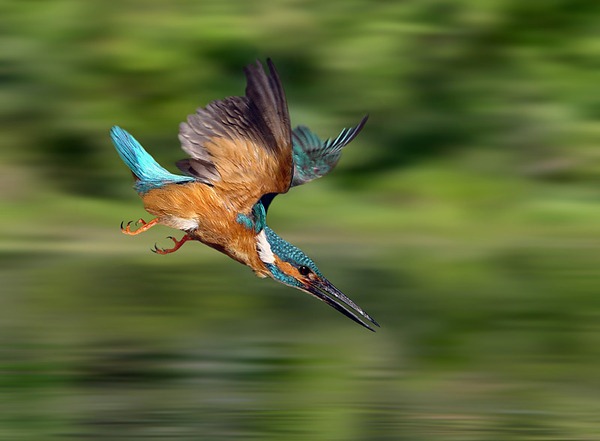
Like a tiny fighter jet, the kingfisher swiftly darts across the water's surface. But it can suddenly halt and, fluttering its ultramarine wings, hover in the air like a magical "blue helicopter." Or, with a loud splash, dive into the water, instantly transforming into a "blue submarine." Or, like a fairy-tale gnome, disappear into a burrow it has dug itself. What an amazing little bird! The English name for the kingfisher, "Kingfisher," means "royal fisher," which reflects the lifestyle of this bird. The Germans call the kingfisher, rather strangely at first glance, "Eisvogel" - ice bird. The Russian name is equally unusual. The fact is that some kingfishers linger in our regions until the very freeze-up. The last kingfishers concentrate near the holes in the ice or at the leads, where they hunt for small fish that come up to breathe oxygen, and where they are usually spotted by people. And one day, after diving one last time into the frigid water, the kingfishers finally leave their nesting places, marking the arrival of the true Russian winter. So those who believe that Father Frost brings winter to our lands along with the Snow Maiden are deeply mistaken. In reality, the Russian winter is brought by small and bright birds - the kingfishers!
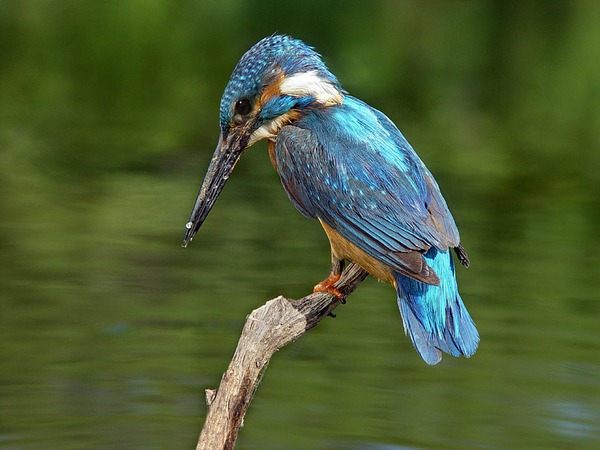
The kingfisher waits for its prey, small fish, sitting on some overhanging branch above the water. If the fish doesn’t bite, the kingfisher flies to another spot and again stares intently into the dark water. Noticing a fish, it doesn’t hurry and very carefully chooses the moment for a precise dive. Meanwhile, the kingfisher makes characteristic head movements, adjusting for the refraction of the image in the water.
We sat quietly by the riverbank, watching the birds fluttering around us. In the coastal bushes, nightingales were chirping anxiously—there, in the thicket, their chicks were hidden. In the crown of a tree leaning over the creek, thrushes were chattering. Suddenly, from somewhere at the far end of the river channel, a piercing bird whistle sounded, and a silhouette of a kingfisher abruptly appeared on a branch sticking out of the water. The bird was holding a small fish in its beak. We froze. Carefully looking around and finding nothing suspicious, the kingfisher fluttered to the riverbank and disappeared beneath the overhanging tree roots! A minute later, the bird swiftly flew back, striking the water's surface forcefully—this is how kingfishers clean their feathers of clinging dirt—and, whistling sharply, darted along the creek. From where it had flown, among the hanging roots, the entrance to a small cave was visible. Shining a flashlight inside, we saw a long tunnel, at the end of which sat six little kingfishers. Thus, the nesting site of the kingfishers was found by us.
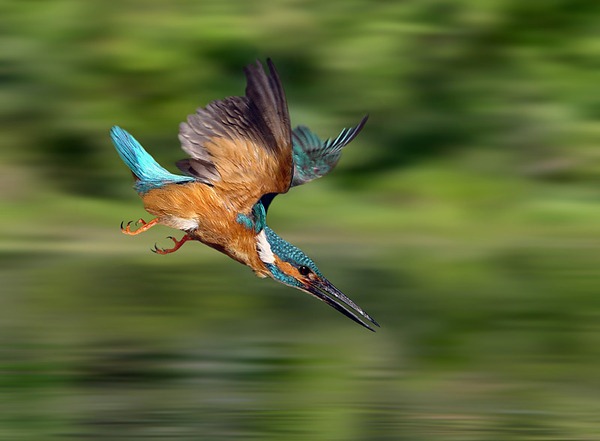
By the way a diving kingfisher folds its legs and wings in the air, one can guess how deep it plans to dive. If the fish is swimming not too deep, the bird folds its wings behind its back and slightly pulls its legs back. This way, it will be easier for it to take off from the water's surface. However, if the prey is hiding deep down, the kingfisher pulls its legs back and folds its wings into a shape similar to an arrow – in this position, it can dive to the desired depth more easily. At the moment of entering the water, the kingfisher's eyes automatically close with a special protective film, so it catches its prey underwater almost blind – relying on memory. Sometimes the kingfisher misses, and instead of a tasty fish, it ends up with a pebble or a piece of algae in its beak. Realizing the mistake, it disdainfully tosses them aside and sulks with indignation.
Where kingfishers are not disturbed, they behave surprisingly boldly and sometimes even shamelessly, for example, perching on the tips of local fishermen's rods. However, before attempting to photograph the family life of kingfishers, it is useful to know some features of their biology. Shortly after arriving, a pair of kingfishers selects a suitable cliff and digs a deep burrow in it. Subsequently, the female lays eggs in it, after which both birds take turns diligently incubating the clutch. But as soon as the newly hatched chicks no longer need warmth, the mother leaves the nest, "entrusting" the feeding and upbringing of the brood to her mate. Meanwhile, she sets off to dig the next burrow for the next clutch, which she will incubate in proud solitude. Subsequently, this story can repeat itself so that, after raising the first brood, the unfortunate male begins to raise the second one while his female may already proceed to her third clutch. Meanwhile, unbeknownst to her "husband," who is entirely occupied with feeding and raising countless offspring, his partner sometimes leads a rather frivolous lifestyle, spinning countless romances with bachelor kingfishers and changing them as one would change gloves. However, thanks to this peculiar reproductive strategy, kingfishers manage to raise up to three broods in one season, each containing between four to seven chicks.
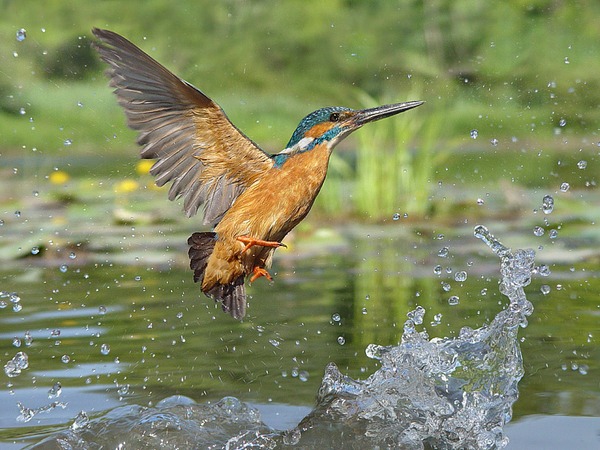
On hot days, you can observe how a kingfisher dives into the water from a distance, creating a splash and then flying off to the side. Do you think it's bathing? Not at all! With this simple trick, the bird scares away small fish that like to hide in the shade of the algae in the heat.
Thoughtless shooting results in thoughtless photographs. Therefore, when preparing to photograph kingfishers, we spent several days without even taking out our cameras, simply sitting with binoculars and observing the inhabitants of the river channel, trying to understand the character and individual traits of each bird. During this time, attention is usually drawn to those moments of behavior that impress the most. Once the behavior of the birds becomes more or less clear, a rough shooting plan is created, with the aim of creating an image that reveals the essence of the photographic subject to the greatest extent. It is often beneficial to make rough pencil sketches of the future shot, which helps avoid compositional mistakes. To start, using a remote shooting method with a hidden camera can be very useful. Birds are almost not afraid of it and often do not even notice it. Furthermore, the entire shooting process can be observed from the outside, which allows for a better understanding of the behavior of the photographed animals and timely correction of mistakes made. An obvious drawback of remote shooting is its low responsiveness, as well as changes in manual settings.
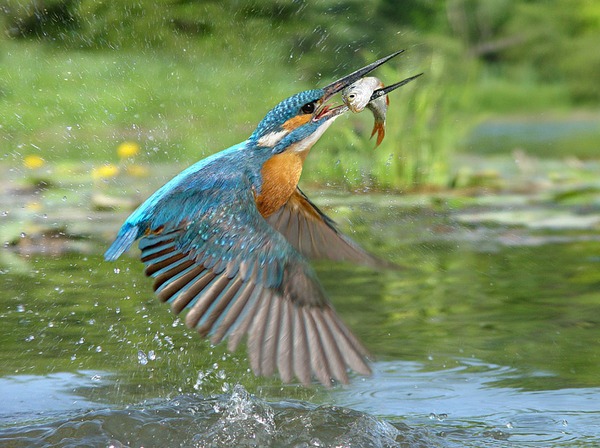
Osprey feathers do not have a water-repellent coating, and when they get wet, they quickly become soaked. If an osprey stays in the water a little longer than it should, its feathers will get wet, and it will not be able to take off from the surface of the water. For this reason, more than a third of young ospreys die each year. Without learning to dive properly, young birds get soaked and, unable to take off from the surface of the water, they drown...
The attitude of kingfishers towards the photography process, like that of many other birds, varies greatly among individuals. Some birds are hardly frightened by the photographer or the sight of the lens. Others, on the contrary, behave cautiously and need to be accustomed to being photographed. The key to success is to never scare the birds under any circumstances! It's important to learn to feel the critical distance, beyond which the bird begins to be frightened by the photographer and to try to stay right at the edge of what is possible, gradually getting the birds used to not fearing humans. Some birds are very much frightened by the lens, which they likely perceive as the eye of a dreadful monster. For example, one of our photo heroes, a kingfisher nicknamed Chivka, could not stand the sight of the lens at all. He would calmly allow people to approach him within less than a meter, but as soon as he saw the lens, he would panic and fly away, not returning for a long time. In such cases, it is useful to cover the front lens with some dense material, like a piece of cardboard. When the bird is engrossed in its activities, you can smoothly open the lens. However, sometimes it’s easier to find another, less skittish bird and work with it instead.
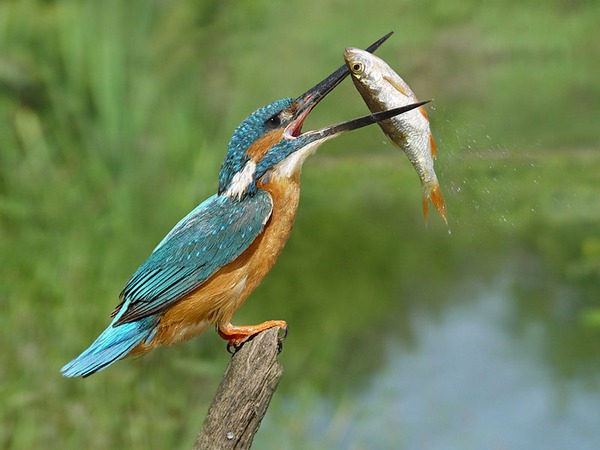
Having caught a fish, the kingfisher carries it to its perch. Here, the bird first strikes the still-living prey several times forcefully against the branch with its head. After this, the stunned prey is positioned appropriately in its beak. If the kingfisher intends to eat the fish, it will place it head-first towards its throat—this makes it easier to swallow. However, if the caught prey is meant for a mate or chicks, the "polite" bird will make sure to lay the fish head-first.
Less timid birds quickly get used to the shooting process. Thus, two or three days after starting photography, the need for remote control usually disappears. Our kingfishers continued to descend onto their favorite perches despite the fact that where the hidden camera had previously stood, there was now a photographer. It became possible to use manual settings and think about how to motivate the birds' behavior to capture the desired shots. Photographing a bird sitting on a branch is the easiest. It’s much more challenging to get pictures of birds in flight or diving. Typically, to capture such shots, you have to "lead" the flying bird with the lens. However, when photographing from close distances, this is almost impossible—the angular speed of a flying bird is so great that the human brain cannot perceive it. Therefore, in these cases, one has to act differently: pre-focus the lens on the desired spot and wait for the bird to fly there. But how to know which branch protruding from the water the kingfisher will land on? And at what exact point in the water will the fish appear and where will the kingfisher dive? How to solve a problem with such a large number of unknowns? The simplest way is to reduce all unknowns to a possible minimum.
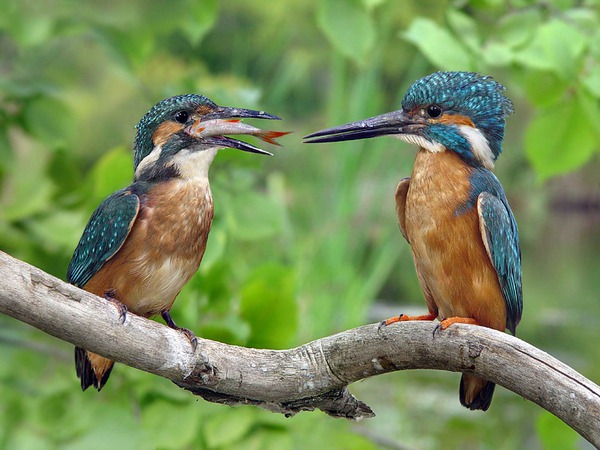
An old male kingfisher watches with great concern as the fish he has caught with much difficulty disappears down the throat of his oversized chick. The young kingfisher has long been flying well and knows how to hunt on its own, but the father still continues to take care of him. At the same time, he looks after the chicks from the first and second broods while his mate is incubating the next, already third clutch of the season. From such a "conveyor belt," the feathers on the old kingfisher's head often stand on end!
Choosing a suitable stretch of riverbank, we took up saws, axes, crowbars, and shovels, and spent the entire day (the eyes are afraid—hands are doing!) clearing it of wood debris and trash. Instead, we arranged other branches and logs, but already in places convenient for us. After that, the kingfishers had no choice but to sit exactly where we needed them. Near one of the most convenient spots, we lowered a fish box-aquarium, glued from thin, transparent plastic, into the water, in which we placed a couple of dozen live fish. To ensure the fish did not suffocate, small holes were made at the bottom of the aquarium to allow free water flow. At the same time, the aquarium was submerged in such a way that its upper edges were slightly below the water level in the river. Now, the spot where the kingfisher would sit and where it would dive had been determined down to the centimeter. All that was left was to calculate the approximate trajectory of the diving bird and choose the right points for shooting. After that, we just needed to wait for the bird to arrive and take as many shots as possible! To avoid waiting too long for the birds, we asked two of our assistants to walk along the far banks of the river bend and drive all the encountered kingfishers to the spot, where, thanks to the photographers’ efforts, all conditions for unforgettable fishing and comfortable rest had been prepared for them.
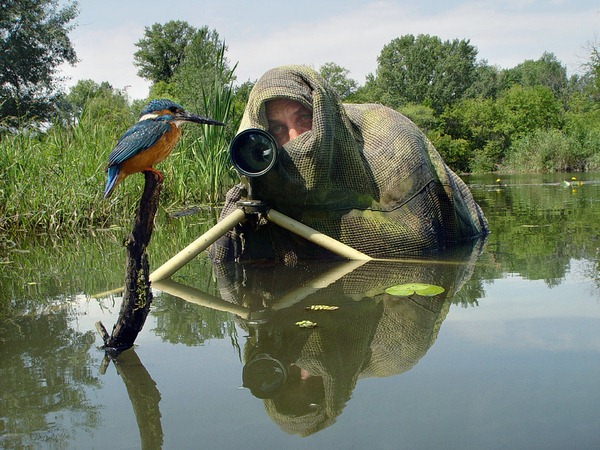
Having completed the photoshoot with kingfishers, I set up the camera with a remote control in front of me, aimed it at the spot where the kingfisher was supposed to land according to my calculations, waited for its arrival, and... pressed the button!
The cover I used to shield myself serves not so much for camouflage as for protection against the countless horseflies that swarm around the wet body. Horseflies bite painfully, and chasing them away in the presence of the kingfisher is not an option—any sudden movements will frighten the bird, causing it to behave more cautiously in the future.